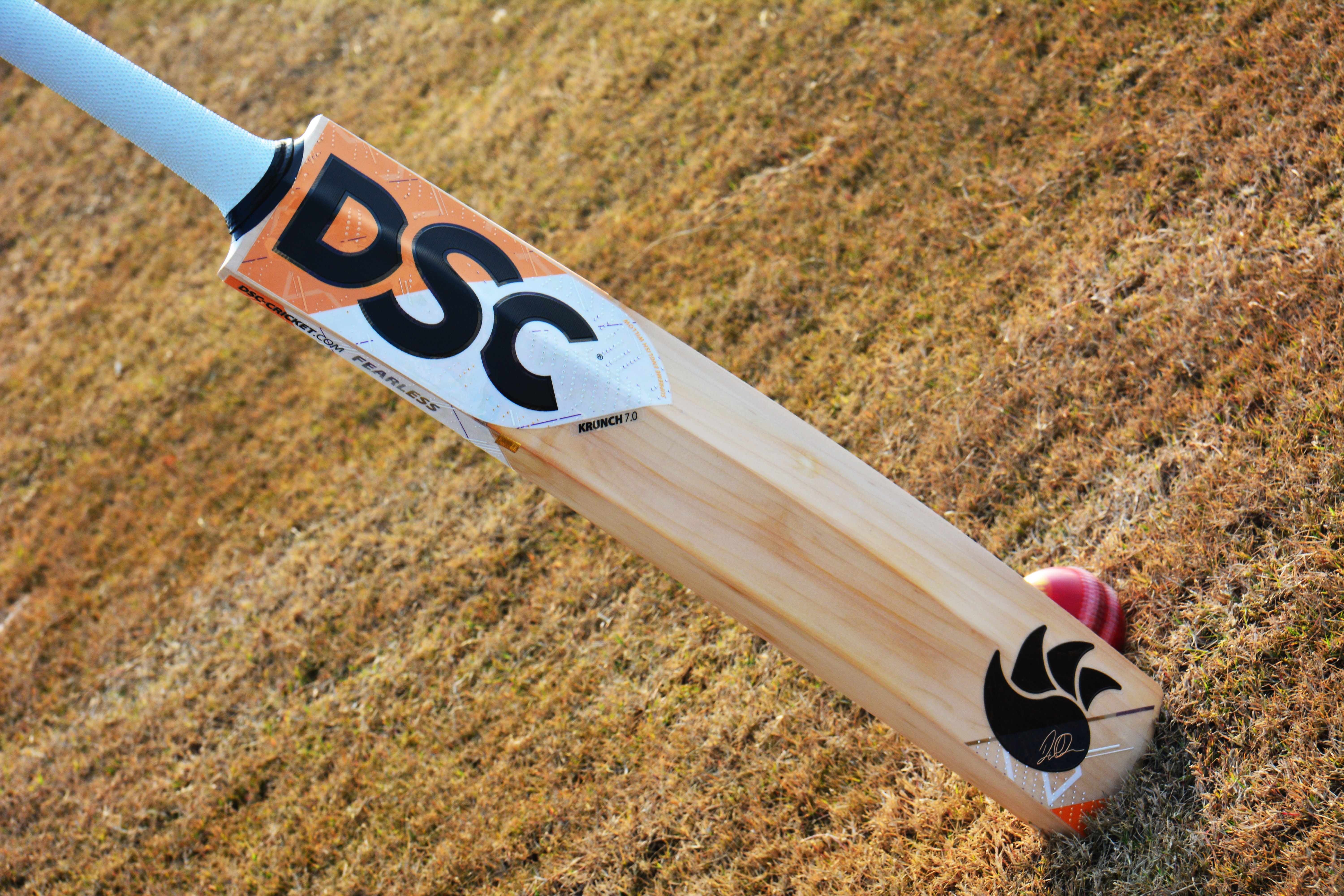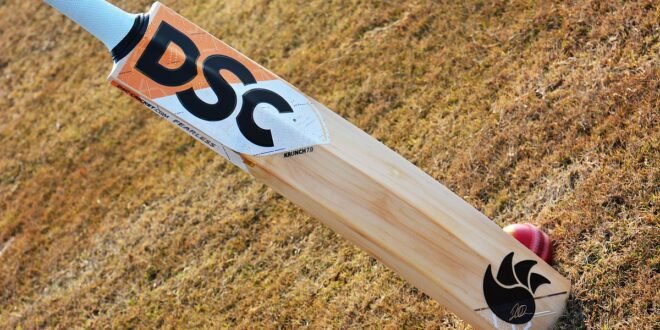A cricket bat is an essential piece of equipment used to hit the ball in the sport of cricket. It is typically made from willow wood for its durable yet flexible properties.
Enthusiasts and cricket players alike understand the importance of a quality cricket bat. Selecting the right bat can significantly impact a player’s performance, influencing factors like timing, comfort, and shot precision. Traditionally crafted from English or Kashmir willow, these bats are shaped and sized to suit different playing styles, ranging from aggressive hitters to technical players.
Ideal bats feature a smooth, flat front surface, or face, with a ridge on the back to provide balance and power. The handle is wrapped in a rubber grip for added control, allowing players to execute a myriad of strokes. Regular maintenance, including oiling and knocking-in, is vital to preserving the bat’s condition. As cricket continues to captivate worldwide audiences, the bat remains symbolic of the game’s rich history and ongoing evolution.
🔴Cricket Bat🔴
Table of Contents
Evolution Of The Cricket Bat
The cricket bat is not just a piece of equipment. It is the batsman’s ally, evolving to meet the changing dynamics of the game. This journey from crude implements to professional gear is a fascinating story.
From Simple Sticks To Modern Blades
In cricket’s early days, players used simple sticks to hit the ball. The bat resembled a hockey stick in shape. It helped in hitting the ball on the ground, as the rules once demanded.
Years passed, and bats began to resemble what we see today. They became straight, allowing players to hit the ball in the air. This changed strategies and game excitement.
Materials And Design Changes Over Time
Materials used in bat making have evolved. Initially, bats were made from a single wood piece. Willow became the preferred choice due to its toughness and shock absorption abilities.
- Willow still makes the best cricket bats. It has ideal properties that lend the bat its power and durability.
- Designs have changed too. Modern bats are broader and have a pronounced bulge. This gives players more power and control.
New technologies have led to changes in handle and blade design. These changes provide better grip and flexibility. Cricket bats have become more player-friendly over time.
| Time Period | Material | Design | Feature |
|---|---|---|---|
| 16th-18th Century | Various Woods | Curved like Hockey Sticks | Ground Hitting |
| 19th Century | Willow | Straighter with V-shape | Air Shots Possible |
| 20th-21st Century | Refined Willow | Broad Blade, Big Edges | Power & Control |
These developments reflect the needs of modern cricket. They have made the game faster, more exciting, and batsmen more powerful. The evolution of cricket bats tells a story of innovation linked closely with the history of the sport itself.

Types Of Cricket Bats
Cricket is not just a game, it’s a passion for many. One of the most important tools in this sport is the cricket bat. Each type is unique, and designed for different playing styles and levels. Let’s explore the various types of cricket bats available.
Classic Willow Bats
Willow trees provide the wood for traditional cricket bats. These trees grow slowly. This process makes the wood dense and durable. English and Kashmir willow are the two main kinds used in making these bats.
- Willow is known for its lightweight and tough nature. Top players often prefer it.
- Kashmir Willow: is slightly heavier and ideal for beginners or casual players.
Historically, these bats have been the go-to choice for professionals all across the world.
Innovative Materials In Modern Bats
The world of cricket is evolving, and so is bat technology. Manufacturers now infuse different materials into willow bats. This increases strength and durability. Carbon fiber, titanium, and even specialized plastics are in use. This innovation helps players hit the ball harder and farther.
| Material | Benefits |
|---|---|
| Carbon Fiber | Increases strength without adding weight |
| Titanium | Enhances power and shock absorption |
| Specialized Plastics | Improves bat lifespan under harsh conditions |
From the traditional craftsmanship of willow bats to the incorporation of space-age materials, cricket bats have come a long way. The type of bat a player chooses can make a big difference in their game, whether they’re a seasoned pro or just getting started.
The Craftsmanship Behind Cricket Bats
A cricket bat is not just a piece of equipment; it’s a marvel of craftsmanship.
Each bat tells a story, carved with skill and precision.
The journey from a willow tree to a finished bat embodies tradition and innovation.
Artistry And Precision In Making
The creation of a cricket bat is a form of art.
Craftsmen select the finest willow, ensuring strength and flexibility.
Wood must dry slowly to maintain its quality.
- Clefts are cut to the perfect size.
- Wood is shaped and sanded by hand.
- Every curve is refined for the perfect stroke.
Balance and weight are crucial. Craftsmen test each bat to meet these standards.
Famous Bat Manufacturers
Some brands are legends in the cricket world.
| Brand | Origin | Notable Players |
|---|---|---|
| Gray-Nicolls | England | David Warner |
| Kookaburra | Australia | AB de Villiers |
| Gunn & Moore | England | Shane Watson |
| Spartan | Australia | MS Dhoni |
These brands uphold high standards of craftsmanship.

Anatomy Of A Cricket Bat
Understanding the anatomy of a cricket bat is key for players at all levels. From the feel in your hands to the way it hits the ball, each part plays a role. Let’s dive into the bat’s key parts and technical specifications.
Key Parts: Blade, Handle, Grip
The blade is the bat’s body. It is where you strike the ball. Made from willow wood, it must be strong and resilient. The handle is the connection between player and bat. It’s typically made from cane and rubber for flexibility and shock absorption. The grip goes over the handle. Grips come in various materials to ensure comfort and control.
- Blade: Main hitting surface, made from willow
- Handle: Connects to blade, made for control
- Grip: Covers handle, ensures comfortable hold
Technical Specifications
The bat’s technical details define its performance. Length, weight, and balance are vital. For juniors, bats are lighter and shorter. Adults use heavier and longer bats.
| Part | Specification |
|---|---|
| Length | Varies by age group |
| Weight | Juniors: Lighter / Adults: Heavier |
| Balance | Depends on the player’s style |
The right bat can change your game. It’s about how it feels in your hands and how it meets the ball. A great bat is a blend of these parts and specs.
Choosing The Right Bat
Every cricket player knows the importance of a good bat. It can change a game. Picking the perfect bat is crucial for any batsman. This guide helps you find the one that suits you best.
Size And Weight Considerations
The size and weight of your bat play a major role in your performance. Bats come in various sizes, from junior to adult. They must match the player’s height for the best control and power.
Here is a quick look at different sizes:
- Size 6: Ideal for players around 5’2″ to 5’6″
- Harrows: Perfect for those between 5’6″ to 5’9″
- Full Size (Short Handle): Best for players over 5’9″ in height
Light bats are easy to handle. Heavy bats provide more power. Balance is key.
Batting Style And Preferences
Your batting style determines the type of bat you should choose. Aggressive players benefit from heavy bats for powerful shots. Technical players often prefer lighter bats for quick reaction time.
Consider the following points:
- Willow Type: English willow is lighter and preferred for its striking abilities. Kashmir willow is heavier but durable.
- Sweet Spot: Lower sweet spots are good for front foot play. Higher sweet spots suit back foot shots.
- Handle Type: Choose between oval or round handles based on comfort and control needs.
Maintenance And Care
Caring for your cricket bat extends its life and boosts your game. Proper maintenance ensures peak performance. We’ll cover how to protect your bat and manage its lifespan, including necessary repairs.
Protecting Your Bat
Shielding your bat from damage is key. Start by applying a protective facing and edge tape. These guard against cracks and splits. Store your bat in a cool, dry place to prevent moisture damage. Use a bat cover when not in use for extra safety.
- Use bat facing to combat ball impact.
- Edge tape for additional side protection.
- Keep in optimal conditions; avoid dampness.
- Cover your bat to shield from dirt and sunlight.
Lifespan And Repair
Regularly check your bat for signs of wear. Small cracks can grow. Early detection leads to simpler, faster repairs. Your bat might need rebinding or a new handle over time. Professional servicing can restore its condition.
| Issue | Solution |
|---|---|
| Surface Cracks | Fill with glue, clamp until set. |
| Loose Handle | Rebind or replace quickly. |
| Dead Spots | Consult a pro for assessment. |
- Inspect bat regularly for damage.
- Act quickly on repairs to save your bat.
- Seek a pro for severe issues.
Cricket Bats And Player Performance
The right cricket bat can be a game-changer on the pitch. Player performance is tightly linked to the quality and type of bat used. Players often select their bats based on comfort, batting style, and the condition of the playing field. A bat that aligns well with a player’s abilities can significantly enhance their performance.
Influence On Batting Technique
The design and weight of a cricket bat can affect how a player swings and makes contact with the ball. Proper bat selection complements a player’s batting technique, allowing for greater control and more efficient power transfer during shots. Let’s break down the elements:
- Weight: Heavier bats provide more power but require greater strength.
- Balance: A well-balanced bat feels lighter to handle and allows for swift movement.
- Size: The bat size must match the player’s height for optimal comfort.
- Handle length: This can impact leverage and shot precision.
Psychological Impact
A cricket bat isn’t just a piece of equipment; it’s a cricketer’s ally. The confidence gained from wielding a familiar and trusted bat impacts a player’s mindset. Here’s how a bat can make a difference psychologically:
- A bat that feels right boosts self-assuredness at the crease.
- Knowing you have a quality bat can intimidate opponents.
- A special connection with the bat can encourage a calmer, more focused performance.

Controversies And Regulations
Cricketers and enthusiasts, prepare to dive into the world of Cricket Bat controversies and regulations. As the game evolves, so do the discussions and rules surrounding the tools of the trade. Understanding these aspects is essential, whether you’re a budding player or a seasoned fan. Let’s explore the current landscape of cricket bat regulations and the fiery debates they spark.
Rules Governing Bat Dimensions
The cricket bat is an essential tool for players, but it’s bound by strict regulations. The International Cricket Council (ICC) sets the rules to ensure fair play. Here’s a snapshot of these guidelines:
| Dimension | Maximum Allowance |
|---|---|
| Length | 38 inches (96.5 cm) |
| Width | 4.25 inches (10.8 cm) |
| Depth | 2.64 inches (6.7 cm) |
| Edge | 1.56 inches (4.0 cm) |
These measurements ensure that bats do not offer an unfair advantage and maintain the sport’s integrity.
Debates Over Technology In Bats
Innovation in cricket bat technology often leads to intense debates. Advancements such as reinforced edges and carbon-fiber materials spark discussion among purists and modernists.
- Purists argue for traditional willow and simple designs.
- Modernists welcome innovation, seeing it as an evolution of the game.
The ICC keeps a close eye on these developments. They make sure technology does not overpower skill.
The Future Of Cricket Bats
The sport of cricket is evolving. So are its tools. Cricket bats are stepping into a future where technology and sustainability are key players. Recent advancements promise to boost performance, enhance player safety, and protect our environment.
Technological Innovations
Tomorrow’s cricket bats are not just about willow and weight. They’re becoming smarter. Connected with sensors, some bats now offer real-time data. Players track speed, angle, and power of each hit. Coaches use this info to tailor training. These technologically enhanced bats redefine how players develop skills.
- Smart Handle Technology: Equipped with piezoelectric fibers to measure bat speed.
- Real-time Data Analysis: Immediate feedback on performance.
- Customizable Weight Distribution: Bats designed to match individual playing styles.
Eco-friendly And Sustainable Options
Sustainability is crucial in cricket bat production. The focus is shifting to materials that reduce the environmental impact. Manufacturers experiment with alternative sustainable woods and bamboo to create eco-friendly cricket bats. These bats offer the same quality while promoting forest conservation.
| Eco-Friendly Material | Benefits |
|---|---|
| Bamboo | Fast-growing and more durable than traditional willow. |
| Recycled Wood | Minimizes waste and makes use of excess timber. |
| Plant-based Fibers | Low carbon footprint and renewable resource. |
With eco-materials, bat makers also aim for zero waste production. They optimize the use of raw materials. They plan to create cricket bats that last longer and support planet health.
Frequently Asked Questions On Cricket Bat
What is the best Cricket bat Material?
The best cricket bat is traditionally made from willow, specifically English willow or Kashmir willow. English willow is highly regarded for its lightweight and excellent grain quality which contributes to better stroke play.
How to choose the right cricket bat size?
Selecting the right cricket bat size is crucial for comfort and performance. Players should ensure the bat feels balanced in their stance and check that the handle reaches just below the waistline when standing upright.
What affects cricket bat performance?
Cricket bat performance is affected by the quality of the willow, the number of grains on the bat face, weight, balance, and the care with which it is maintained. Proper knocking-in and oiling can significantly improve bat performance.
Can cricket bats be repaired?
Yes, cricket bats can be repaired, especially for issues like surface cracks, loose handles, or damaged toe. Skilled professionals can restore bats, extending their life and maintaining performance.
Conclusion
Selecting the perfect cricket bat can elevate your game to a new level. Ensure it matches your playing style and comfort. Remember, the best bat isn’t just about cost; it’s about compatibility. Embrace the sport’s spirit with the right gear, and let your cricket bat be your ally on the pitch.
Step up to the crease with confidence, ready to face every delivery with your ideal bat in hand.
 Cric Enjoy Sports News, Cricket Update, Live Streaming
Cric Enjoy Sports News, Cricket Update, Live Streaming







